We already wrote about your most compelling opening line to start the dialogue. Dialogue is fun: you can invite as many people as you and your issue want and need. Everyone can join whenever they want and they have privacy if they want. They learn from each other and rate your dialogue with a big eight! For your question design we have a whitepaper with 18 design principles, designing your question with our unique QuestionDesignLab and inspiration for the best completion of your question.
In addition, we share here some complete texts as an invitation to your dialogue about how they have been used by organizations in previous dialogues. This means that 100,000s of people were involved, challenged and activated to think along, solve the puzzle and initiate change, collectively! Real change and transformations are a people-centric activity: whether the change is small (new working methods, new schedules) or major (energy transition, reorganization). Leadership of teams, departments and the entire organization, municipality, healthcare institution or other type of company thus embrace the power of people thinking, reflecting and increasing each others’ opening up to change. Quite a bit different from listening to people delegate to HR who delegates it to a survey platform. Everyone now admits that surveys have not delivered what they promised (even the CEOs of these types of platforms), that follow-up hardly takes place, and involvement, trust and connection have become weaker. Gallup currently measures that in many countries only dozen(s) % of employees consider themselves actively engaged.
We all need to move towards a new model of ‘listening’. One that we believe should be based on trust, dialogue, connecting and performing together. Close to work, close to change, close to action and above all: together. Driven by managers and open questions, supported by HR, instead of driven by HR surveys, with reports sent to managers. This applies not only to government organizations, healthcare, education, but also to commercial organizations and governments. And not only with their internal people, but also with their external people: patients, customers, members and residents.
Back to your dialogue: how do you compose your invitation? What do you need and want to say in it? How do you involve and touch your target group? How do you provide context and inform them?
What do we say in CircleLytics itself, when you draw up your invitation for your dialogue:
- What is the call to action? What do you ask them? So that opening line…
- What is the context, what information do participants need?
- Who else do you ask besides the invitee who reads your invitation?
- What is your intention to do with the results?
- What would you like to share about the follow-up after your previous dialogue with this group?
- How does this working method work, online, asynchronously, via two rounds?
- What is the power of privacy, i.e. anonymity for participants?
We share below some invitations for your next dialogue, for your inspiration. Are you inspired by what others have designed? What will you change about these texts? Does it help you compose your dialogues faster and better? Whether it concerns challenging your team and preparing it well for a meeting next week, or inviting 1,000s of employees to make a change process more successful.
“More and more people are combining their job with caring for a loved one. Usually things go well, but the combination of work and informal care can also be challenging. We therefore ask you four open questions anonymously, to learn from all of you. What are we going to do with it?
Your opinions will be sent back anonymously to the rest of the participants in a few days. You value the opinions of others and in this way we know what we together find most important within the theme of informal care, and what not, and what could be improved. We will immediately return these action points to all managers, with instructions.”
“We are switching from our periodic survey to this dialogue. Much more fun, because there are only a few questions, they are open, because we are open to your opinion. And: you will hear back immediately about the results: you will receive an invitation to the second round, in which you can appreciate answers from others and enrich them with your recommendation to realize it.
This way it becomes fun, action-oriented and you together indicate what is most important and what is not. This allows us to send each manager a to-do list on the same day the dialogue ends!
Everything is anonymous and from now on we will do this every quarter on 3 to 5 topics maximum. From now on, we will involve you in topics that really matter and take action together. We are extremely curious about your ideas and solutions.”
“In our increasingly complex working environment with increasing workload, we, as HR want to continue to dialogue with you together and with the works council. In this way we learn together to know and pay attention to our energy, cooperation and the continued development of our organization, for our customers.
So no survey, because we work with open questions after which you can read the (differing) answers of others, learn from them and appreciate help. As a result, we know what really has support and we will discuss this result with the management in two weeks. We would like to emphasize that all contributions and results are anonymous. We want you to see the results concretely in your work. Thank you in advance.”
“Thank you for participating in this online dialogue for the new policy for ABC.
When creating this new policy, the patient is central and that is why we take your opinions into account when creating this new policy. By participating you directly contribute to improving care for people affected by ABC.
This dialogue consists of two rounds: in the first round you will be asked 3 open questions and 2 profile questions. Then you get to see the answers of others, then think differently than you. You can then respond to this; Do you agree with the others, do you agree with their ideas? Why, what is your advice on what we can do with this? As soon as round 2 starts, further explanation will follow in the invitation you will receive.
Privacy is well regulated with this working method: you participate from wherever you want, at your own time and it is anonymous.”
“Prior to our meeting next Friday, in which some of you will also participate, we would like to ask two questions to everyone who has to do with ABC. We have opted for this working method, anonymous and composed of two rounds. All answers from you and other participants are then selected and sorted using smart software and offered to you again. During the week, the second round starts and you can read and assess the answers of other participants. Which one do you think is best, what is your action point? Which one? If you don’t like it, why not?”
“In order to be able to have a concrete conversation with all managers during our quarterly day, we will also ask you this quarter to answer the open questions (and two closed) in this dialogue anonymously. This is possible until Thursday. After that you will be invited to to participate in round 2. You will then have the opportunity to respond to the answers of your colleagues and attach a score to them: what do you support and what do you not, and what is your specific suggestion? When the second round is concluded, a valuable ranking, with support!
The results are discussed in detail during the quarterly meeting. This way, managers can immediately start working on the best results and actions in their teams.”
“Your input as a new employee at ABC is very valuable. In this online dialogue we will look together for the best ideas to present and profile the organization as an attractive employer based on a unique set of values that you find important.
We conduct this dialogue online, in an equal and anonymous manner. It will provide important ideas and insights into how ABC can better attract talent on the labor market and therefore be less affected by the staff shortage.
We have 5 questions ready that you can answer in no more than 10 minutes. Thank you again for making some time for this! In the second round you can learn from others again, and they from you. We are curious to see what will come of it. At the end, you will personally receive the results with the most highly rated contributions to our issue by email.”
And if they are used to this working method, you can limit your invitation to, for example:
“As you know, there is a major shortage of nurses. 20% more training places are needed to guarantee emergency care in the future. From September we will therefore train more students than now. We are very happy that many colleagues are have shown interest for our training. How great would it be if we kept them on board after their training.
Welcoming, coaching and inspiring these nurses-in-training is a task for all of us. We need your help too. We would love to hear what you need and what ideas you have to set this up properly together. The better we know what is needed, the better we can help each other. Will you participate again? Anonymous of course!”
Or even shorter:
“Many thanks again for our meeting last Wednesday. Not everyone could be there, and of course time was limited in such a meeting. That’s why now a few more questions for you and the entire Top 50. Anonymously and at your own time. After you have answered a few questions yourself, and the first round ends, you will be invited to the second round, in which you can appreciate and supplement the opinions of others. So listen, learn and formulate actions together.”
And if it is a follow-up dialogue to a previous one….
“Thanks to the previous dialogues, meetings and decision-making, we have implemented the new management structure. We are curious whether you are already noticing the effects of this change, both in a positive sense and in a critical sense and where you see improvement possible or necessary .
This time we will ask you three open questions through this online dialogue. In the first round you answer the questions and in the second round you can view and rate the answers of your colleagues. All responses are anonymous, so your input in the first round counts equally, and everyone’s support for others’ contributions in the second round counts equally. The results of the dialogue are immediately available and therefore immediately scheduled for the following week. This way we can quickly achieve improvement and action together. Thank you again!”
“We are curious about your opinion about the tasks of the role of ABC. In order to listen and understand you as front line employees in our region, we will regularly have these online, anonymous dialogue with you. Unlike a survey, you can read each other’s answers, learn from these and vote these up or down. Unlike a meeting, we offer privacy, time to think and we can all really participate and have influence.
So see this dialogue as an online way to work together smarter, securely. The results will be shared with you through your manager and this has already been planned and agreed upon. You can access the link to answer the questions from your laptop or phone, 24 hours a day. So choose your own moment. Thank you in advance for your contribution.”
“You have been working with the existing roster arrangement for several years. This is currently being evaluated and perhaps revised. We are curious about your input. How do you experience the rosters? What is good or could be improved. Tell us now anonymously, respond to the input from others and together, in this online way, show what the ‘new schedules’ project team should pay attention to. In this way we do our best to include as many wishes as possible. So please join us and tell us and tell us tell us what we should pay attention to?”
“As announced, you will receive the online dialogue with which you can give your opinion and ideas to make our team day a success. To get a good idea of what we consider important together, we have four questions for you. In the first round you can you can give your response and in the second round you can view the contributions of colleagues and indicate to what extent you support or reject this idea or opinion. You can immediately give a recommendation so that we can take action together more quickly. This way a supported prioritization will be established, which we will further elaborate during our team day.”
“How is team-based working currently developing for you and for your team? We want to learn from your experiences in this new phase of team-based working. With this dialogue, as a change project team we want to hear from you through open questions how you view different aspects of team-based working and where you need more or different support. This allows teams to learn from each other and we learn how further implementation from teams can be relaxed and improved.
As after previous dialogues, the project team ensures that the results have a direct impact on the acceleration, deceleration and reinforcement that the teams need. This is how we build change together.”
And who also sees these types of extremely short texts, if this working method is used regularly? It therefore replaces a meeting, which is often expensive, more difficult to plan, not everyone comes, and usually does not offer time to listen to each other and reflect. Managers save a lot of time but also improve quality.
“I would like you to think about the following so that we can quickly solve and prevent this. You know how it works: two rounds, anonymously and I will come back to our choices based on the results on Monday.”
And if your issue is quite sensitive, or it is in a very early phase:
“We have started the ABC project, to achieve …. We want to understand in this early phase, what initial thoughts you have about this. Would you like to share them anonymously and then indicate what you think of others’ opinions, and why? We do this with this online dialogue, via two subsequent rounds. As a project team, we are curious about this first dialogue and do not yet know what we can do with it in concrete terms: first we want to listen! We may do it more often do with everyone involved at ABC.”
And if you want to go through decision-making with your target group:
Through previous dialogues and workshops with different groups, we have learned that there are four main topics. The dialogues also made it clear to us what we mean by these topics and what steps are required. This means we can now make decisions with you. Very nice to work together with so many people in this way!
For each decision we will ask whether you agree with it, together with your substantiation. If this is not the case, we would like to hear what objection or alternative you have. In the second round you see the reactions of others and you can support them with your scores or not. Everyone can then give a new and definitive answer to the question of whether you agree with the proposed decision. We will find out whether many supported objections can still be taken into account. Everything is anonymous, and in three weeks you will know the result. Thank you!
That’s it for now. We design hundreds of invitation texts this way every year, and so do our customers! Follow our blogs and posts on Linkedin and stay informed of new cases, inspiration and more about the power of people who think, experience, learn and solve together. Are you planning an appointment with us to get acquainted, for a demo or to help design your dialogue?
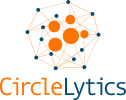



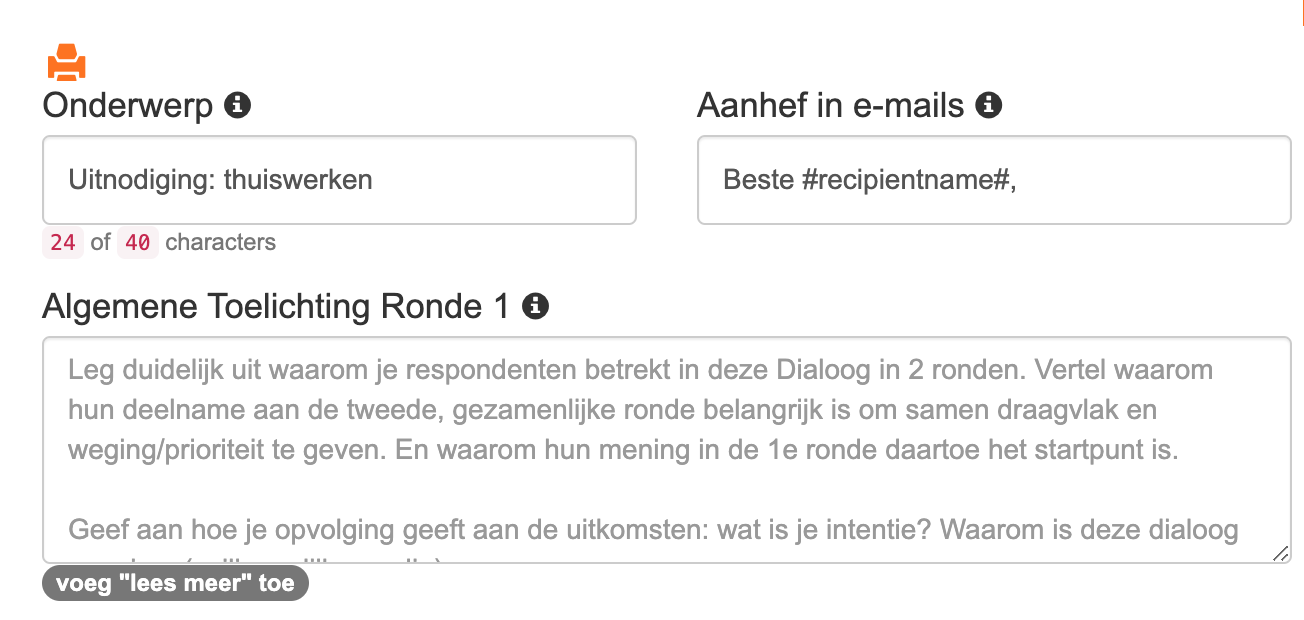 Subject of your dialogue
Subject of your dialogue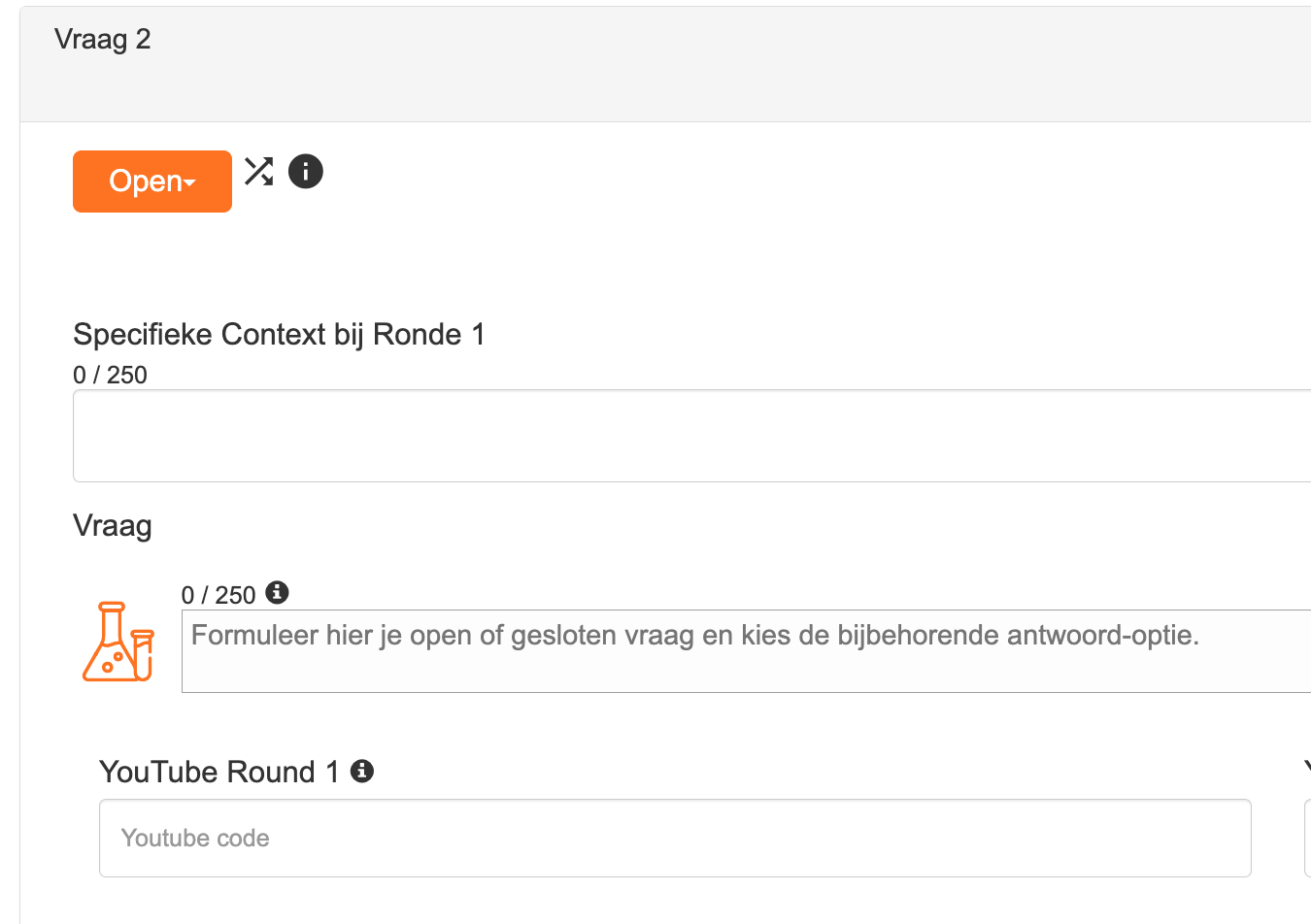
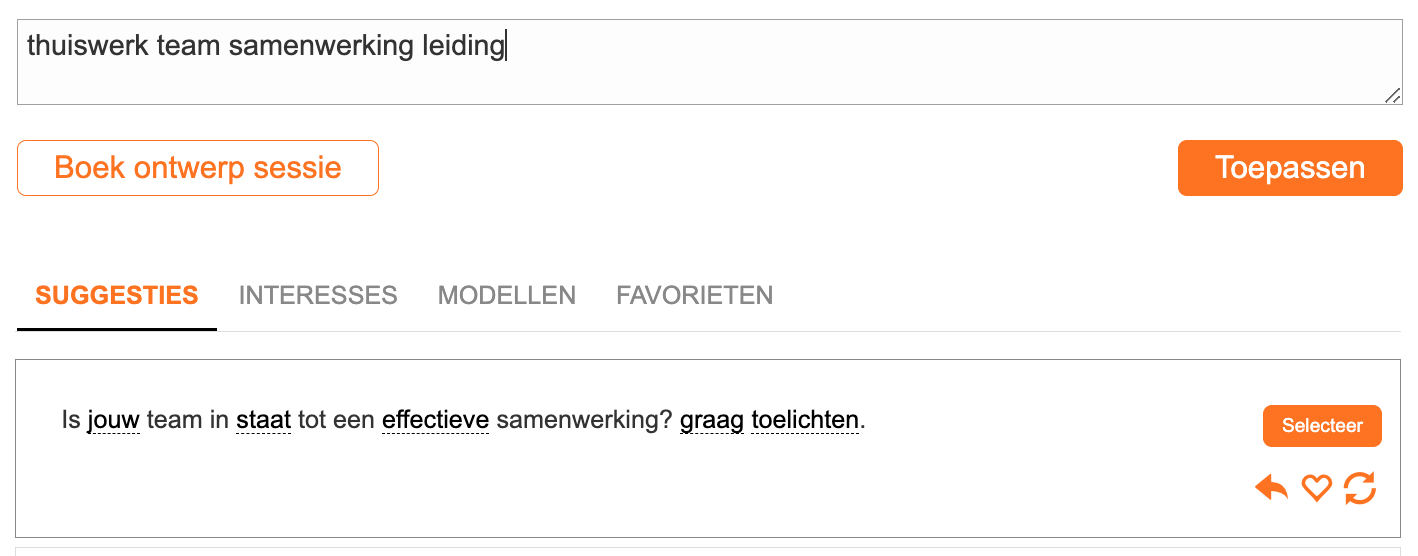
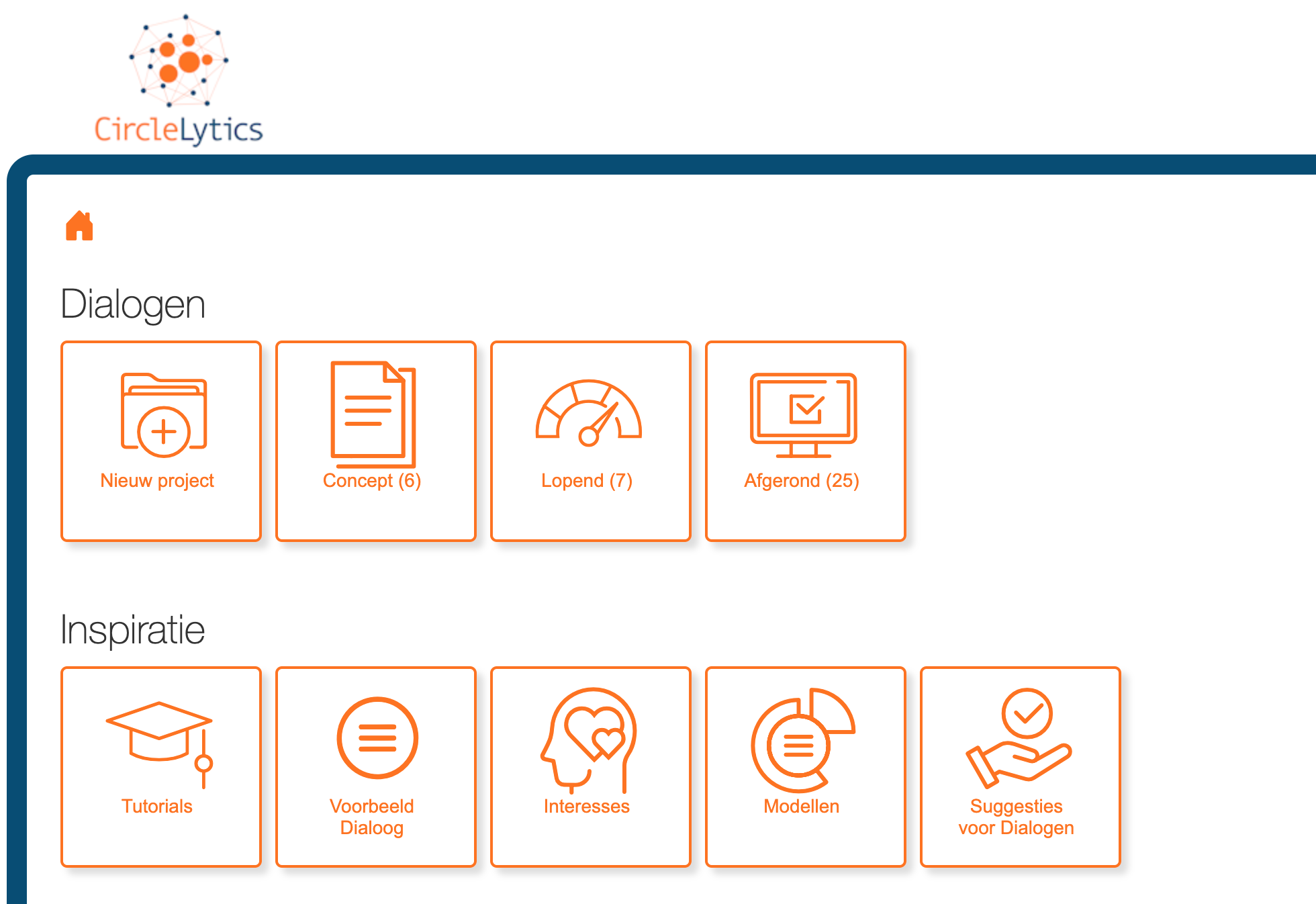 In your dashboard, your homepage, you can activate Interests and Models, see the screenshot below. These preferences then feed the QuestionDesignLab to provide more intelligent suggestions. When you are in the QDL lightbox itself, you can also search very specifically for suggestions by clicking the Interests or Models tab (see screenshot below). You will then receive suggestions that already belong to those Interests or Models. If you stay at the suggestions tab in the QDL lightbox, we will ensure that the suggestions shown take your interests and clicked models into account. We are going to add many more models by the way.
In your dashboard, your homepage, you can activate Interests and Models, see the screenshot below. These preferences then feed the QuestionDesignLab to provide more intelligent suggestions. When you are in the QDL lightbox itself, you can also search very specifically for suggestions by clicking the Interests or Models tab (see screenshot below). You will then receive suggestions that already belong to those Interests or Models. If you stay at the suggestions tab in the QDL lightbox, we will ensure that the suggestions shown take your interests and clicked models into account. We are going to add many more models by the way.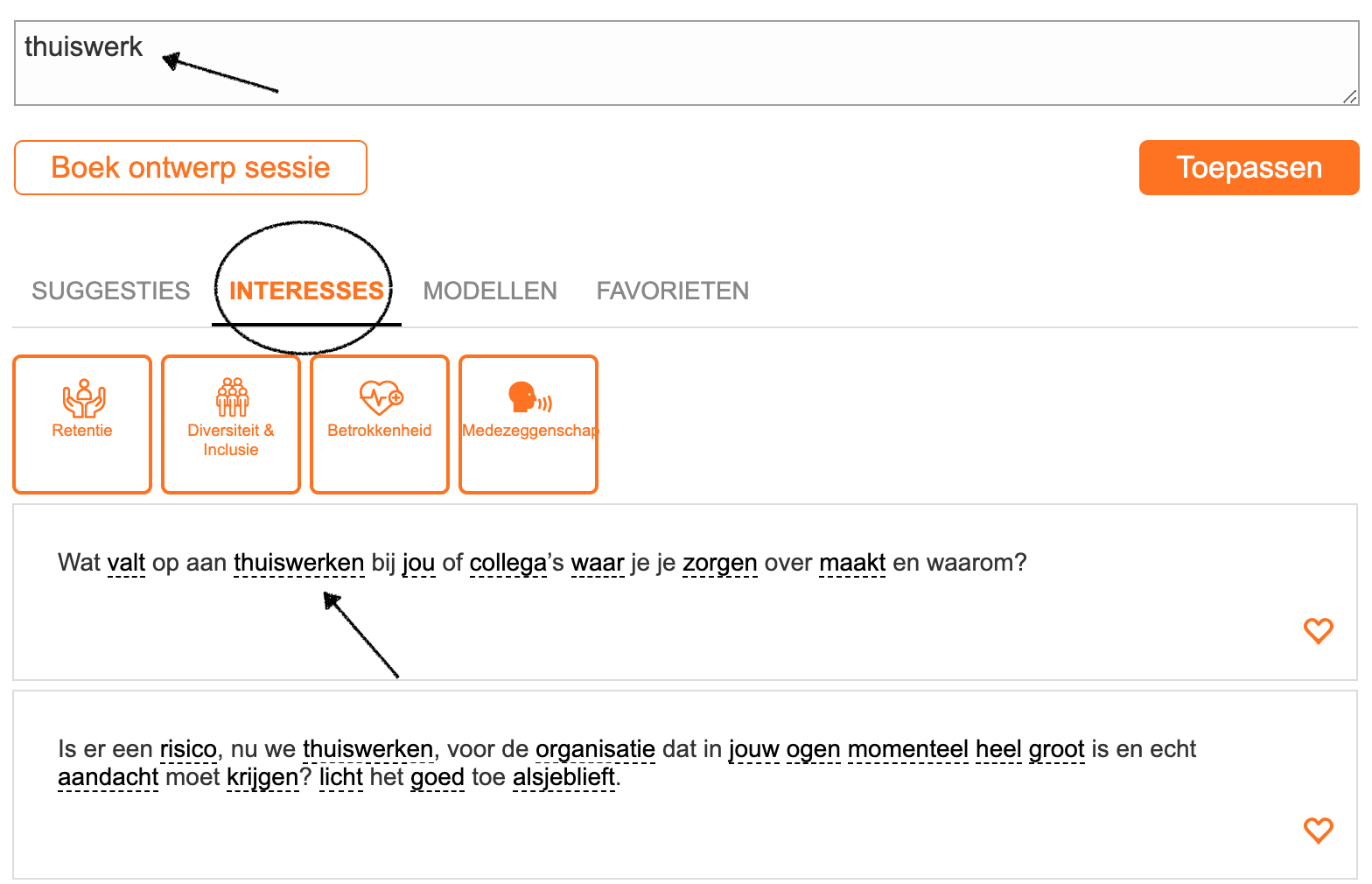
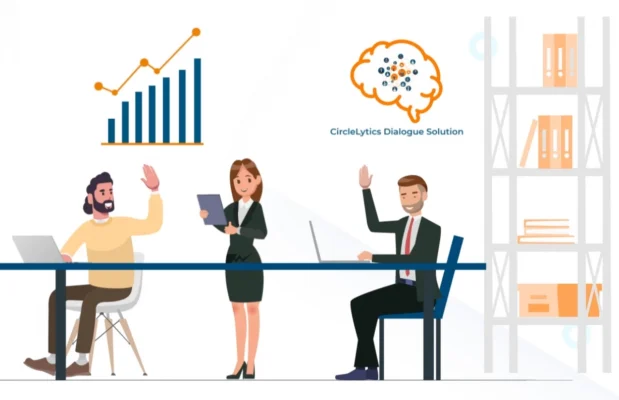

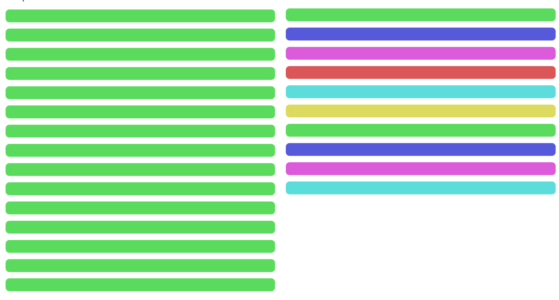 Clustering – playfully expressed with colours for you here – ensures that contributions from round 1 are grouped together based on similarity. Participants only see a few contributions from the same cluster (see picture: a few times the same colour). We have developed a technique of cleverly ‘jumping’ between clusters, showing the participant a varied set of contributions. This way we mitigate the very unwelcome
Clustering – playfully expressed with colours for you here – ensures that contributions from round 1 are grouped together based on similarity. Participants only see a few contributions from the same cluster (see picture: a few times the same colour). We have developed a technique of cleverly ‘jumping’ between clusters, showing the participant a varied set of contributions. This way we mitigate the very unwelcome 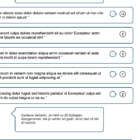 Then, for every 5 contributions, we will show that new message as you can see in the picture on the right: we will thank you and tell you again that you may stop or continue. The participant is free to do so. Sometimes participants read over it. But not anymore; the message is now like a sort of button. Did you know that more than 70% of the participants rated more than 30 contributions? More than 50% of the participants even rate more than 40-50. This means a huge involvement of participants and apparently a nice, attractive experience for them. Your solid questions, relevance of subject matter and
Then, for every 5 contributions, we will show that new message as you can see in the picture on the right: we will thank you and tell you again that you may stop or continue. The participant is free to do so. Sometimes participants read over it. But not anymore; the message is now like a sort of button. Did you know that more than 70% of the participants rated more than 30 contributions? More than 50% of the participants even rate more than 40-50. This means a huge involvement of participants and apparently a nice, attractive experience for them. Your solid questions, relevance of subject matter and 